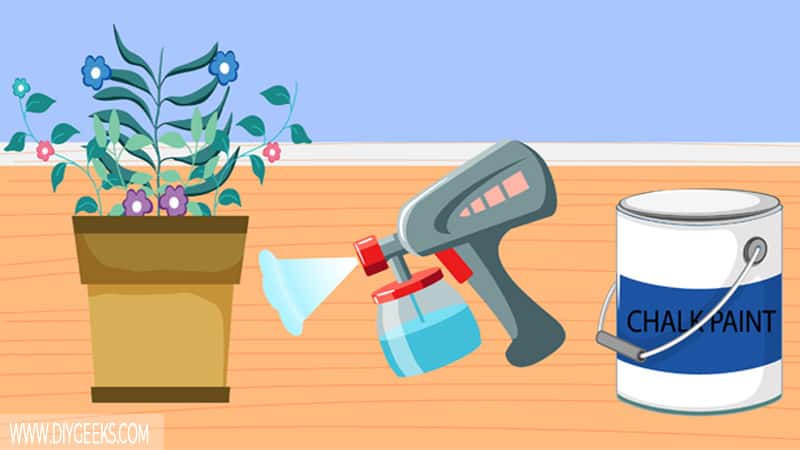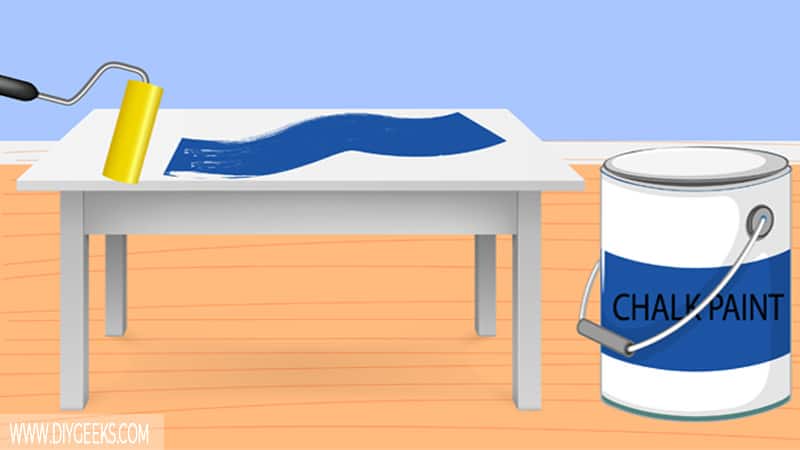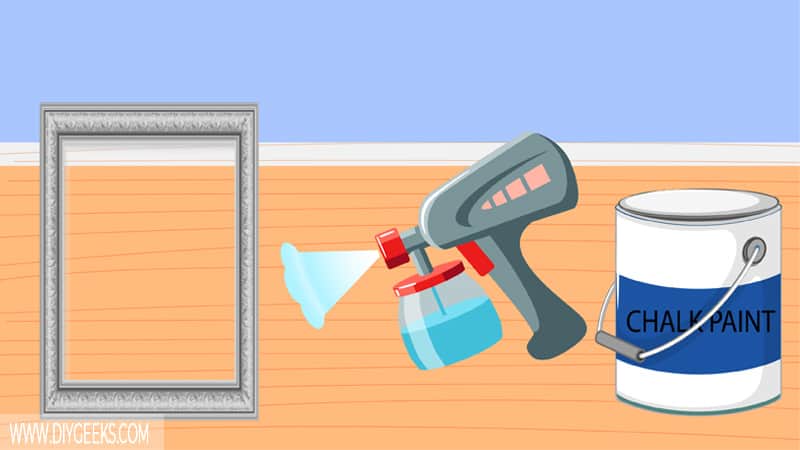Plastic is a non-porous material, while chalk paint is a water-based paint with a thick viscosity.
You can apply chalk paint on plastic, but you must clean and sand the plastic surface to remove imperfections and bumps that prevent paint adhesion.
Cleaning removes the dust, dirt, and grime from the plastic, and sanding removes the imperfections and creates tiny holes (pores) the paint can penetrate.
How To Apply Chalk Paint on Plastic?
To apply chalk paint on plastic, do the following things.
- Prep the Workspace.
- Clean the Plastic.
- Remove the Existing Finish (If any).
- Sand the Plastic.
- Prep the Paint.
- Apply Chalk Paint.
Prepping the plastic surface before applying chalk paint is important as plastic is non-porous and doesn’t allow penetration.
1. Prep the Workspace
Prep the workspace by removing nearby objects and covering the floor with a drop sheet to prevent paint spills.
2. Clean the Plastic
Clean the plastic surface to remove dust, dirt, and grime that can prevent paint adhesion. Paint won’t stick and will peel off if you don’t clean the plastic surface.
To clean the plastic surface, do the following things.
- Mix warm water with soap or detergent.
- Apply the mixture to the surface.
- Use a soft brush to scrub the dirt.
- Wait 5 minutes.
- Rinse the plastic with clean water.
3. Remove the Existing Finish (If any)
If the plastic is already painted or sealed, remove the paint or sealer before applying chalk paint. The sealer will produce a glossy finish and prevent chalk paint from penetrating the plastic surface and adhering.
If the existing paint is oil-based remove it as chalk paint doesn’t adhere to it.
To remove an existing finish from plastic surfaces, do the following things.
- Apply a paint remover compound over the surface.
- Wait a few minutes.
- Use a plastic scraper to remove the paint.
- Re-apply the paint remover compound to leftover paints.
- Use a rag to remove the leftover paint.
- Rinse the surface with clean water.
If the surface isn’t painted or sealed, skip this step.
4. Sand the Plastic
Wet-sand the plastic surface to remove imperfections and bumps, and create tiny holes that paint can penetrate into.
To sand plastic use fine-grit sandpaper (220-grit) as it won’t damage or heavily scratch it. Avoid dry sanding or using coarse or medium-grit sandpaper as it will scratch the plastic.
Clean the surface after sanding.
Related Read: Can You Sand Chalk Paint?
5. Prep the Paint
Prep the chalk paint by shaking the container and stirring the paint before using it. If you don’t prep the paint, it will have an inconsistent flow and color.
Thin chalk paint if it’s too thick as thick coatings won’t adhere to non-porous surfaces well. To thin chalk paint, use water in a ratio of 1:4 (1 part water to 4 parts paint).
6. Apply Chalk Paint
To apply chalk paint, do the following things.
- Use a paintbrush or sprayer.
- Apply 3 coats.
- Wait until one coat dries before applying the next one.
- Sand between coats (except the last coat).
- Wait for the last coat to dry fully (cure) before using the surface.
Optionally, you can seal the finish with spar varnish, polyurethane, or wax for outdoor plastic surfaces.
Related Read: Will Chalk Paint Stick To Glass?
How Long Does Chalk Paint Take to Dry on Plastic?
Chalk paint takes around 15 minutes to dry to touch, 30 minutes to dry enough for a re-coat, and 24 hours to cure (fully dry) on a plastic surface.
The exact dry time is determined by the humidity levels, surface type, room temperature, and the number of coats and thickness. For instance, paint takes longer to dry if the humidity levels are high and the room temperature is low as its solvent (water) takes longer to evaporate.
For chalk paint to dry, its solvent (water) must evaporate and the coating must become rigid and hard.
Chalk paint dries faster on plastic surfaces than on any other surface. That’s because the plastic surface is non-porous, so the paint doesn’t penetrate its surface. This means the evaporation process (of the solvent) happens faster because all the paint is over the top layer of the surface.
Do You Need To Seal Chalk Paint on Plastic?
You need to seal chalk paint for outdoor plastic surfaces, but you don’t need to seal it for indoor surfaces.
Chalk paint isn’t durable enough and doesn’t have protective additives that make its coating strong enough to withstand outdoor weather elements. Unsealed chalk paint won’t last more than 6 months if exposed to constant rainfall or water.
A sealer will produce a glossy and moisture-resistant layer over the chalk paint and protect it from moisture, water, and scratches. Use wax, spar varnish, polyurethane, or lacquer to seal chalk paint.
A sealer will produce a clear coat over the coating and protect it from water, moisture, scratches, handling, and other damage. To seal chalk paint use wax, lacquer, or polyurethane.
Which Types of Plastic Surfaces Can You Apply Chalk Paint on?
Furniture
You can apply chalk paint on decorative plastic furniture as they aren’t exposed to constant water or usage.
Don’t apply chalk paint on high-traffic or outdoor furniture surfaces as the paint isn’t durable enough to protect it.
Plant Pots

You can apply chalk paint on indoor plastic plants, but you can’t apply it on outdoor plastic plants unless you seal the paint.
Tables

You can apply chalk paint on plastic tables, but you must seal the paint as the tables are exposed to constant usage and water that can remove the paint.
To prevent water from penetrating the paint, seal the finish on tables with flat surfaces. When water is spilled on them, the water won’t slide down but instead stays on the table, potentially removing the paint.
Picture Frames

You can paint plastic picture frames with chalk paint because they aren’t exposed to water, usage, or moisture. You also don’t have to seal the finish.
To apply it chalk paint on plastic picture frames, do the following.
- Remove the picture.
- Clean and sand the frames.
- Apply 3 coats of chalk paint.
- Wait until the final coat dries before hanging the picture frame.
However, if the picture frame is exposed to a lot of usage or handling, seal it with wax.
[sc name=”chalkpaintplastic1″]


